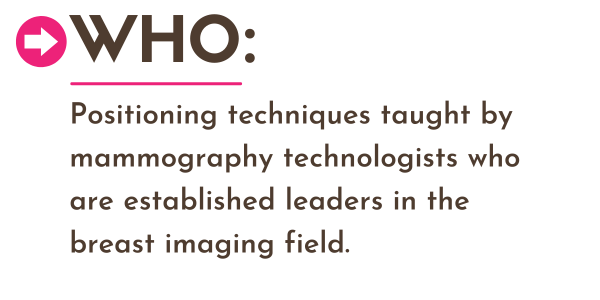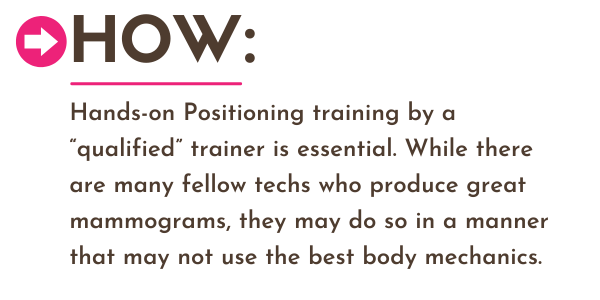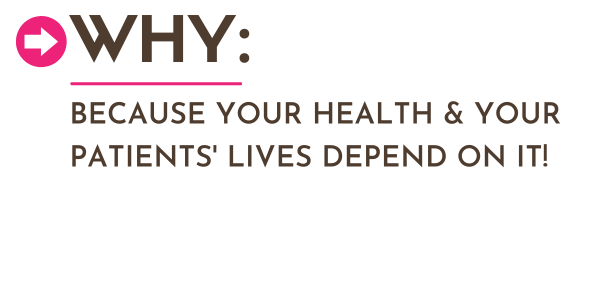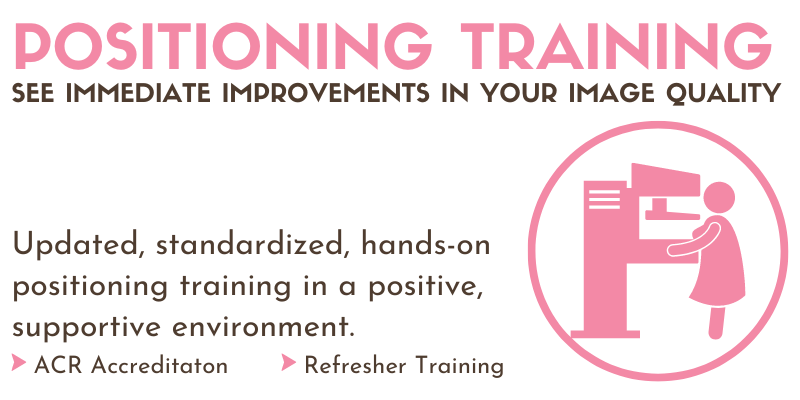How did you learn to position?
Did you go to the “See one, do one, teach one” school? How about the “Watch one, botch one” academy?
Positioning training is the most important aspect of your current or future role as a mammographer. After all, it is what you spend 90% of your time doing on the job. . .and your patient’s lives depend on it!
When I started doing mammograms in the late 1980’s, we were just thrown in there. Unlike general radiology, there were no classes that would help us understand breast anatomy, how to position or what our images were supposed to look like. This was new to both of us. There were not many classes for Radiologists and definitely no classes for Mammo Techs. So, we just plugged along. . .

MQSA was established in 1994, mostly to make sure our patients were receiving the best mammograms possible. This required all technologists who were performing mammograms to get 40 hours of education. No specifications as to who taught it or what was taught, especially regarding positioning techniques. Yes, there were content specifications, but there were not a lot of variables when teaching anatomy, physiology and physics. It just was what it was. Teaching “positioning” constituted the explanation of screening and diagnostic views. Clinical criteria was fairly standard but “how” we were taught to position was widely, and sometimes wildly, variable! There were no “how to” standards, except the minimal information that was provided in the 1994 and 1999 ACR Manuals. All photographs of positioning were done on F/S equipment and MQSA also required 15 hours of mammography CEUs every 3 years.
Fast forward to “modern” mammography.
Full-Field Digital Mammography (FFDM) was approved in 2000 and Digital Breast Tomosynthesis (DBT) was approved in 2011, but again, no updates have been made to the ACR manual despite these equipment changes, which included increased width, length and thickness of the IR (compared to the bucky), as well as changes in the face shield size. Many of us “figured out” how to make the changes needed to produce quality images, but I believe that one of the foundational problems is that there was no real standard for mammography positioning that follows the concept of positioning general radiology exams, which are done the same way, in the same sequence, all over the world!
However, with mammography, as previously mentioned, there is no specific requirement for how you are taught to position; just what your images are supposed to look like. The unfortunate result is that most mammographers were and are not currently learning techniques and principles that apply to positioning of all other radiography exams. Whether it be a CXR, foot, ankle, pelvis or complete L-spine, we all position the same way, using the same sequence. Worldwide positioning techniques for general radiology are consistent, reproducible, efficient, proficient and probably most importantly, ergonomically sound. In other words, we all do them the same way, thus making the technique much easier to teach and replicate. We can do them faster and with less repeats and perhaps most importantly, we are (or should be) taught to perform the exams in a manner that protects us against unnecessary and often avoidable injury, especially work-related, repetitive motion injuries (1).
Not everyone who teaches mammography positioning applies these same standards.
I have been to hundreds of breast centers and have worked with thousands of mammo techs. Very rarely do they all position using the same technique (most techs use varying sequences.) If you have been trained in the past 20 years, you probably know this from experience. Every tech has her own version of how she positions. This makes it extremely difficult for newer techs to figure out which “version” to use, but even more importantly, without standardized positioning techniques, our image quality suffers and our bodies suffer. Those of you who are younger and/or new to the field must consider your positioning techniques to avoid some of the positioning related injuries that you see and hear your colleagues experience.
Additionally, image quality has suffered due to poor positioning techniques. 90% of all images sent for ACR Accreditation fail for image quality related to positioning issues. The FDA states that poor positioning can reduce the sensitivity of mammography by 18.1% (2)!
Houston, we have a problem! I will not get into the details of what I think caused this problem (there are more than what I have stated above... and that’s a whole other blog), but after 30+ years of experience as a mammographer and educator, I do know that HOW you position and WHO you learn from makes a BIG difference.
So, here are some of my recommendations. . .

1) Look for those who have published articles in respected journals.
2) Look for those who have been speakers at national conferences (not at their own business-related meetings).
3) Look for those who have volunteered their time towards advancing mammography technologist education.

1) Look for DATA and/or articles that prove their techniques produce better mammograms (3)!
2) Why is data important? It’s the foundation of every scientific recommendation. Mammography positioning should be no different.
3) Positioning techniques should feature sound ergonomic principles. Ergonomics is a science! Correct techniques will help you avoid and/or improve positioning related pain and injury which is a real problem for mammographers and sonographers! You should be taught techniques that will help you avoid injury…not cause it!
4) Ask yourself when comparing techniques (if that is possible): What makes sense to you? What requires less movement and strain to your hands/body? What produces the best results?

1) Good positioning is a combination of many factors. Learn from someone who takes all those factors into account.
2) Also, times have changed and positioning methods have been modified and improved. I would like to see an amendment that MQSA requires mandatory hands-on positioning training (to be provided by the employer) every 5 years. The techniques must be proven to improve image quality and follow strict ergonomic guidelines to reduce/avoid positioning related injuries.
3) Be open to change! When we have been doing mammograms for many years, using a specific technique and we get pretty good results, it is hard to change. I understand! Change is tough, and it takes time to adapt to new techniques.
4) We also have to consider that muscle motor memory is a huge part of that challenge. Our hands, arms, shoulders and back all kind of "go" into place, in the same way we have taught them to “go”. You may not even realize that the way they move may be hurting you. But again, after working with thousands of technologists in hundreds of facilities over the years, I can tell you that change DOES produce amazing results.
5) After a great training you should produce better images while using the best techniques that are Standardized, Consistent, Reproducible, Efficient, Proficient and Ergonomically Sound.





